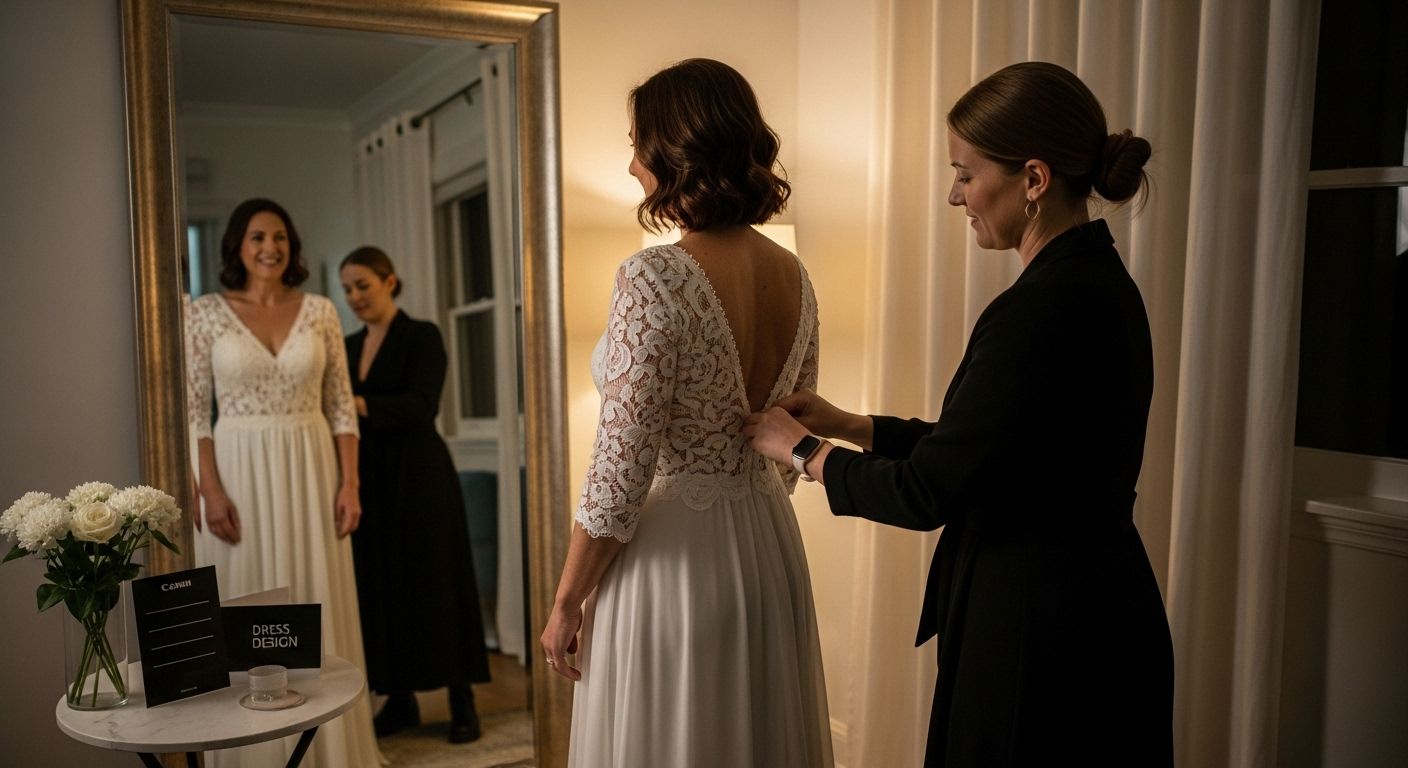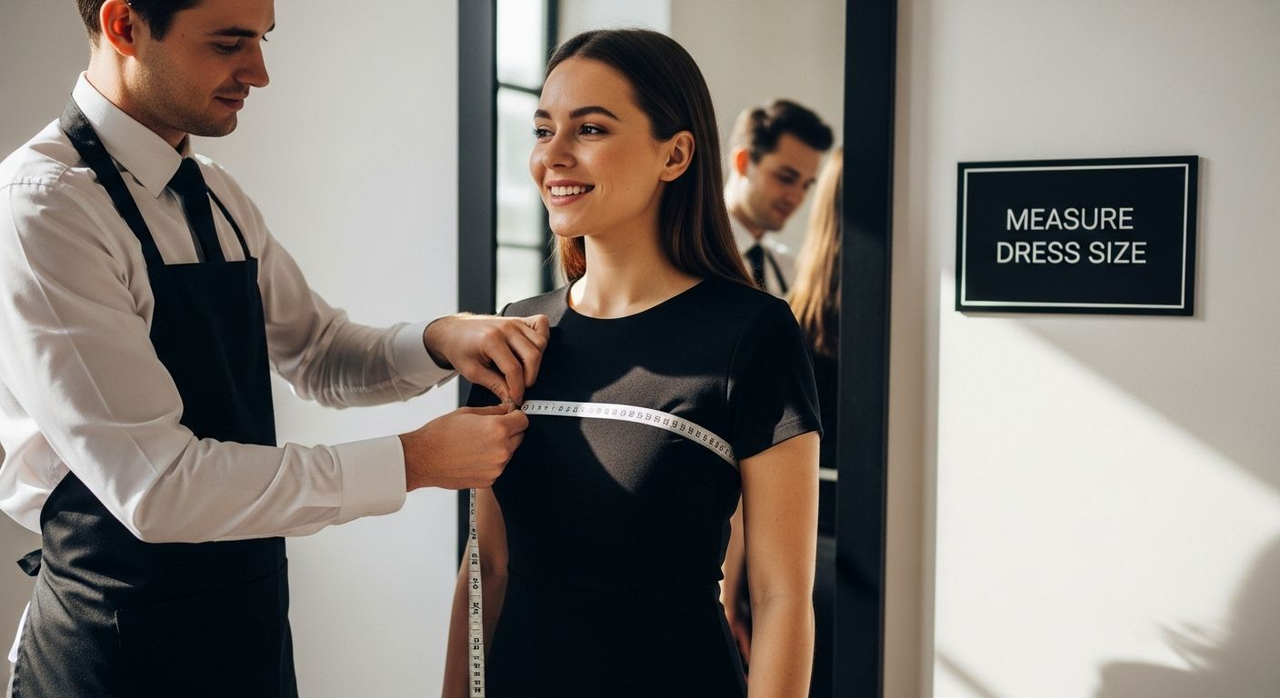How to Measure Dress Size for Special Occasions
How to Measure Dress Size for Special Occasions

Finding the perfect dress for weddings, proms, or any big event starts with one simple step: knowing your exact size. Most people think shopping by standard dress sizes is the way to go and end up frustrated when the fit just feels off. The truth is, using a flexible, non-stretch measuring tape can make the difference between constant adjustments and a flawless, made-for-you look. Accurate measurements do more than just save you the hassle at the tailor—they help you look and feel your best from the very first try.
Table of Contents
- Essential Tools For Measuring Dress Size
- Step-By-Step Guide To Taking Measurements
- Choosing The Right Dress Based On Your Measurements
- Common Mistakes To Avoid When Measuring
Quick Summary
| Takeaway | Explanation |
|---|---|
| Use a flexible measuring tape | A soft, non-stretch tape ensures accuracy when measuring body dimensions. |
| Measure critical points twice | Repeating measurements helps verify accuracy, ensuring the best fit for your dress. |
| Stand naturally during measurements | Maintain a relaxed posture to achieve true body dimensions without appearing stiff. |
| Document measurements systematically | Use a tracking sheet or mobile app for precise recording of sizes and adjustments. |
| Consider professional fitting adjustments | Always factor in the potential need for alterations to achieve the perfect dress fit. |
Essential Tools for Measuring Dress Size
Accurately measuring your dress size requires precision and the right set of tools. While many people assume any measuring tape will work, professional results demand specific equipment and techniques. Understanding how to measure dress size starts with selecting the appropriate measuring tools and knowing exactly how to use them.
Professional Measuring Equipment
The foundation of accurate dress size measurement is a high-quality flexible measuring tape. Professional tailors and fashion experts recommend using a soft, non-stretch measuring tape specifically designed for body measurements. Consumer Reports suggests investing in a fabric measuring tape that maintains its accuracy and does not stretch during measurements.
Key characteristics of an ideal measuring tape include:
- Flexibility: Ability to curve around body contours
- Accuracy: Clearly marked measurements in inches and centimeters
- Material: Soft fabric that won’t irritate skin
- Length: Minimum 60 inches to accommodate various body sizes
Additional Measurement Tools
Beyond the basic measuring tape, several complementary tools can enhance measurement precision. A full-length mirror helps ensure proper tape placement and alignment. Some professional tailors also recommend using a body measurement chart to record and track measurements consistently.
Other helpful tools include:
- Form-fitting clothing: Wear tight undergarments or form-fitting clothes during measurements
- Clipboard or measurement tracking sheet: Record measurements systematically
- Smartphone or camera: Document measurements for future reference
Digital Measurement Technologies
Embracing modern technology, several innovative solutions now assist in dress size measurements. Advanced body scanning technologies and smartphone apps can provide surprisingly accurate sizing recommendations. Fashion Technology Institute reports that some digital tools can create a near-perfect 3D body model with just a few smartphone photos.
These digital measurement tools offer advantages like:
- Instant size recommendations
- Ability to track body changes over time
- Compatibility with online shopping platforms
- Reduced human error in manual measurements
Whether using traditional measuring tapes or cutting-edge digital technologies, the key is consistency and precision. Taking multiple measurements and comparing results ensures the most accurate dress size determination. Remember that dress sizes can vary between designers and brands, so always approach measurements with patience and attention to detail.
To help you quickly compare the strengths of traditional, complementary, and digital measurement tools, here’s a summary table outlining their main features and benefits:
| Tool Type | Key Features | Benefits |
|---|---|---|
| Flexible Measuring Tape | Soft, non-stretch, fabric; marked in inches & centimeters | Accurate body measurements; skin-friendly |
| Additional Tools (mirror/chart/etc) | Mirror, body measurement chart, tracking sheet, smartphone | Ensures correct placement; organized data |
| Digital Technologies (apps/scanners) | Body scanning, smartphone apps for 3D modeling | Size recommendations; tracks body changes |
Step-by-Step Guide to Taking Measurements
Measuring your body accurately is crucial for finding the perfect dress fit. Textile Learning emphasizes that precision starts with preparation and a systematic approach to taking measurements.
Preparing for Measurement
Before beginning, create an ideal measurement environment. Wear form-fitting undergarments that closely represent your body shape. Sewing Workshop recommends using an elastic band at the natural waistline to help identify key measurement points. Stand in a relaxed, natural posture with feet shoulder-width apart, ensuring your body is straight but not rigidly positioned.
Key preparation steps include:
- Proper Clothing: Wear tight-fitting undergarments
- Body Position: Stand naturally with good posture
- Measurement Surface: Use a full-length mirror
- Temperature: Ensure the room is comfortable to prevent body tension
Critical Measurement Points
Accurate dress sizing requires measuring multiple body points. Wikisource Dressmaking Guide provides a comprehensive breakdown of essential measurements. Start with the bust, which is the most critical measurement for dress fitting. Wrap the measuring tape around the fullest part of your chest, keeping the tape parallel to the floor and ensuring it’s snug but not tight.

Essential measurements to take include:
- Bust: Measure around the fullest part of the chest
- Waist: Find the natural waistline and measure circumference
- Hips: Measure around the widest part of the hips
- Shoulder Width: Measure from one shoulder point to another
- Back Length: Measure from nape of neck to waist
- Arm Length: Measure from shoulder to wrist
Advanced Measurement Techniques
Professional dressmakers use advanced techniques to ensure absolute precision. Take each measurement at least twice and compare the results. When measuring length-based areas like dress length or sleeve length, stand straight and have someone help you measure for maximum accuracy. Use a soft measuring tape that can conform to body contours without stretching.
Pro tips for advanced measurement accuracy:
- Multiple Measurements: Take each measurement twice
- Assistant Help: Request assistance for hard-to-reach areas
- Relaxed Breathing: Measure during normal breathing
- Consistent Tension: Keep measuring tape snug but not tight
Remember that dress sizes can vary significantly between designers and brands. Always refer to specific size charts and consider having a professional fitting for special occasion dresses. Measuring yourself carefully ensures the best possible fit and helps you feel confident in your chosen outfit.
Choosing the Right Dress Based on Your Measurements
Selecting the perfect dress involves more than just matching numbers to a size chart. Textiles and Garment Construction emphasizes that understanding your body measurements and proportions is crucial in finding a dress that not only fits but also flatters your unique shape.
Understanding Body Shape and Proportions
Every body is unique, and dress selection should celebrate individual characteristics. Home Economics Research suggests taking comprehensive measurements to identify your body’s natural proportions. Horizontal, vertical, and circumferential measurements provide insights into which dress styles will complement your figure.
Body shape categories typically include:
- Hourglass: Balanced bust and hip measurements with defined waist
- Pear: Wider hips compared to shoulders
- Apple: Wider upper body with less defined waistline
- Rectangle: Minimal difference between bust, waist, and hip measurements
- Inverted Triangle: Broader shoulders compared to hips
Dress Design and Measurement Strategies
Professional designers use strategic design techniques to enhance body proportions. Garment Construction Guidelines reveal that diagonal lines and strategic fabric placement can visually alter body perception. For instance, dresses with vertical seams can create a lengthening effect, while empire waists can balance proportions for various body types.
Key design considerations include:
- Neckline: Choose styles that complement your shoulder width
- Waist Placement: Select designs that highlight or minimize your natural waistline
- Fabric Weight: Heavier fabrics provide structure, lighter fabrics offer fluidity
- Color and Pattern: Use visual tricks to balance body proportions

Practical Fitting and Alteration Tips
Even with precise measurements, some tailoring might be necessary for the perfect fit. Consider these professional recommendations:
- Professional Fitting: Have a tailor assess the initial fit
- Alteration Allowances: Budget for potential dress modifications
- Undergarment Considerations: Choose foundation garments that smooth and support
- Comfort Test: Ensure you can move comfortably in the dress
Remember that standard size charts are guidelines, not absolute rules. Your unique body measurements matter more than a number on a label. Confidence comes from wearing a dress that fits well and makes you feel amazing. Take time to understand your measurements, explore different styles, and don’t be afraid to make minor alterations to achieve the perfect fit for your special occasion.
Common Mistakes to Avoid When Measuring
Measuring yourself for a dress can be tricky, and even small errors can lead to significant fitting problems. University of Nebraska-Lincoln Extension highlights that precision is crucial when taking body measurements for special occasion attire.
Positioning and Posture Errors
Improper body positioning is one of the most frequent measurement mistakes. Standing incorrectly can dramatically alter your measurements, leading to ill-fitting dresses. Many people unconsciously adjust their posture, sucking in their stomach or standing unnaturally stiff, which distorts true body dimensions.
Common positioning errors include:
- Tension: Holding breath or tensing muscles
- Unnatural Stance: Not standing in a relaxed, natural position
- Incorrect Alignment: Tilting shoulders or hips
- Inconsistent Posture: Changing position during measurement
Measurement Technique Mistakes
Technical errors can completely undermine your measurement accuracy. The measuring tape must be kept parallel to the ground and maintain consistent tension. Garment Construction Experts recommend using a soft, non-stretch measuring tape and avoiding pulling it too tight or leaving it too loose.
Critical measurement technique mistakes to avoid:
- Uneven Tape Placement: Not keeping the tape level
- Inconsistent Tension: Varying tape tightness
- Wrong Tape Type: Using stretchy or inaccurate measuring tools
- Measuring Over Thick Clothing: Interfering with true body contours
Contextual Measurement Challenges
Beyond physical measurement techniques, several contextual factors can impact accuracy. Your current body state, clothing, and even time of day can influence measurements. Factors like recent weight changes, water retention, or wearing different undergarments can create subtle but significant variations.
Additional measurement context considerations:
- Time of Day: Measure when body is most consistent
- Recent Body Changes: Account for weight fluctuations
- Undergarment Selection: Use consistent, form-fitting undergarments
- Physical Condition: Avoid measuring when bloated or immediately after exercise
Professional dress fitters recommend taking multiple measurements at different times and comparing results. If possible, have someone else assist you to ensure the measuring tape remains straight and accurately positioned. Remember that most special occasion dresses can be slightly altered, so a near-perfect measurement is typically more important than an absolutely precise one.
Ultimately, understanding and avoiding these common measurement mistakes can save you significant time, money, and potential disappointment. Approach dress measurements with patience, attention to detail, and a willingness to double-check your work.
Here’s a handy checklist summarizing common mistakes and factors to watch for when measuring yourself for a dress. Use this table as a reference to avoid pitfalls and ensure the most accurate fit:
| Mistake/Challenge | Example/Error | How to Avoid |
|---|---|---|
| Positioning/Posture Errors | Tensing, bad alignment, unnatural stance | Stand relaxed and straight |
| Tape Placement Mistakes | Tape not level, too tight/loose | Keep tape parallel and snug |
| Wrong Measuring Tools | Stretchy tapes, thick clothing | Use soft, non-stretch tape |
| Contextual Factors | Time of day, body changes, undergarments | Measure consistently, track changes |
| Not Double-Checking | Only measuring once | Take each measurement twice |
Frequently Asked Questions
How do I properly measure my bust for a dress size?
To measure your bust, wrap a flexible measuring tape around the fullest part of your chest, ensuring that the tape is parallel to the floor and snug but not too tight.
What measurements do I need to take for a dress?
You should measure your bust, waist, hips, shoulder width, back length, and arm length to determine the best dress size for you.
Why is it important to use a flexible measuring tape?
A flexible measuring tape can conform to your body contours, providing more accurate measurements compared to rigid tape, especially around curves and edges.
How can I avoid common mistakes when measuring for a dress?
To avoid mistakes, stand in a relaxed, natural posture, use a soft measuring tape, take each measurement twice for accuracy, and document your results systematically.
Ready for a Flawless Fit on Your Big Day?
You have just learned how vital accurate measurements are for special occasion dresses. A perfect fit supports your confidence, ensures you look amazing in every photo, and lets you shine without worry. You also know small missteps with posture or tape placement can ruin a dress that should have been unforgettable. But after all your careful measuring, finding a store that turns those numbers into your dream look can be a real challenge.

Why settle for guesswork when you can experience the confidence of tailored elegance? At Dress Me Up NY, our beautiful collections of evening gowns, prom dresses, and wedding guest outfits make it easy to match your exact measurements with trending styles. Browse our latest designer arrivals and enjoy exclusive online perks like discounts and free shipping on select orders. Make every measurement count and step into your next event with a dress that truly feels as good as it looks. Visit Dress Me Up NY now and find your perfect special occasion dress today.
Recommended
- Tarik Ediz 54199 Taffeta Plunging Neck Sleeveless Long Dress
- Colette by Daphne CL8300 Stretch Sequin Stretch Lining Dress
- Size Chart of designs
- Terani Couture 251P4056 Stretch Metallic Asymmetric Dress

